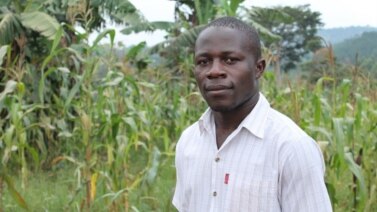
From VOA Learning English, welcome to As It Is. I’m Steve Ember in Washington.
Today on the program, we visit a banana farm in Uganda and hear about genetically-engineered bananas. They are designed to resist disease.
But first, demand for meat, milk and eggs is growing around the world. Karen Leggett has our report.
Demand for Meat Leads to Changes in Farming
To meet that demand, the way these products are produced is changing. The change is from small farms to large, industrial operations. This has already happened in the United States. But not everyone is happy with the change. As a result, there is also a growing demand for products grown locally on small farms.
In Clinton, North Carolina, some old buildings are all that remain from the days when James Lamb raised hogs next to his home. He saw that small farmers were having trouble competing with companies that own large farms.
“They had better consistency, better pork quality, better genetics. So after college, in ’98, I decided to try to modernize.”
He stopped raising hogs in small buildings and built two industrial-sized hog barns. Each of them holds 1,500 hogs.
Nearly all pigs are raised this way in the United States now. The government says the efficiency of large-scale production in a controlled environment has helped reduce the price of a pork chop by nearly 20 percent since 1998.
These efficient and intensive production methods are being used around the world. Many experts say that is a good thing as the demand for meat grows. But livestock expert Carolyn Opio points out that the land, water and feed required to produce it are limited.
“If we are to produce within the constraints that we are facing today, efficiency, I think, is very, is key.”
Ms. Opio is with the United Nations Food and Agriculture Organization.
But the results of efficiency are not always necessarily good. The waste from thousands of confined animals can pollute waterways and produce greenhouse gases. And some health experts are concerned about the antibiotics and other chemicals being put in the animals’ feed. Others criticize the conditions in which the animals are kept.
So today, a growing number of people are like Kevin Summers in Amissville, Virginia, and returning to small-scale farming.
“In order to feed the world, I think this is a better way. It’s a, you know, it’s a cleaner way. It’s a more humane way.”
More Americans today say they want to know where their food comes from. Some might like the way Kevin Summers raises his hogs.
“I can see the entire process unfold before my eyes and know that they had a good life and were healthy and happy.”
The hogs eat damaged apples and old pumpkins. This reduces food waste. But this kind of farming also means higher prices. Even so, Kevin Summers says he believes it would still be possible to meet global demand this way.
“And it would just involve people making the choice to buy this kind of food and say that, ‘I care about something other than just the cost.’”
I’m Karen Leggett.
And I’m Steve Ember with As It Is from VOA Learning English.
Scientists continue to debate the value of genetically modified organisms, or GMOs. These plants and animals have been genetically engineered. Scientists have made changes to their genetic material.
Today, we take you to Uganda and a small banana plantation, where GMO bananas are being grown.
Growing Debate Over GMO Bananas in Uganda
The trees are healthy and green. But Andrew Kiggundu does not like what he sees.
“The disease on the leaves you see right now is not the wilt, it’s a different disease called black sigatoka. It is just killing off the leaves and causing significant yield loss. This is a big problem.”

Andrew Kiggundu works with the National Agricultural Research Organization, also known as NARO. The Ugandan government agency is developing genetically-engineered bananas. The new plants are meant to resist black sigatoka and banana bacterial wilt, which has been destroying large amounts of the country’s banana crop.
Uganda is the world’s top consumer of bananas. NARO Research Director Wilberforce Tushemereirwe says this is why it is so important to produce healthy plants.
“The disease keeps on moving around, and wiping out garden after garden, so you will go to areas where you find they have changed from banana to annual crops. And that has already introduced food insecurity, because they are not used to handling annual crops.”
The central African nation already permits testing of genetically modified organisms or GMOs. Lawmakers are considering a bill that would permit the development and distribution of such organisms throughout the country.
But some activists say genetically-modified organisms would be dangerous to human health and the environment. Giregon Olupot is a soil biophysicist at Makerere University in Kampala.
“There are a range of options that risk to be wiped [out], just by this technology. With bananas, tissue culture has worked well to engineer healthy plants. You then take these plants to a clean garden and maintain field hygiene. Why are we not giving emphasis on that technology?”
Most genetically-modified seeds are patented. This means farmers must purchase them after each planting. Mr. Olupot says this might be possible for profitable farms, but smaller farms depend on their own seeds. In his opinion, selling genetically-modified seeds to small farmers could trap them.
“If you are to go commercial, it has to be on a large scale. Now, the farmers we are talking about, on average, have 0.4 hectares of land. It is simply not suitable for our farmers.”
A public institution is developing Uganda’s genetically-modified bananas. NARO says no patent laws will restrict their use. But Mr. Olupot says this would probably not be true with genetically-modified crops introduced to Uganda in the future.
Mr. Kiggundu says opponents of genetically-modified plants have been strong in their criticisms. He says many farmers are now afraid of GMOs.
I’m Christopher Cruise.
And that is As It Is for today. I’m Steve Ember. Thanks for joining us! For the latest world news, be listening to VOA at the top of every hour, Universal Time.





